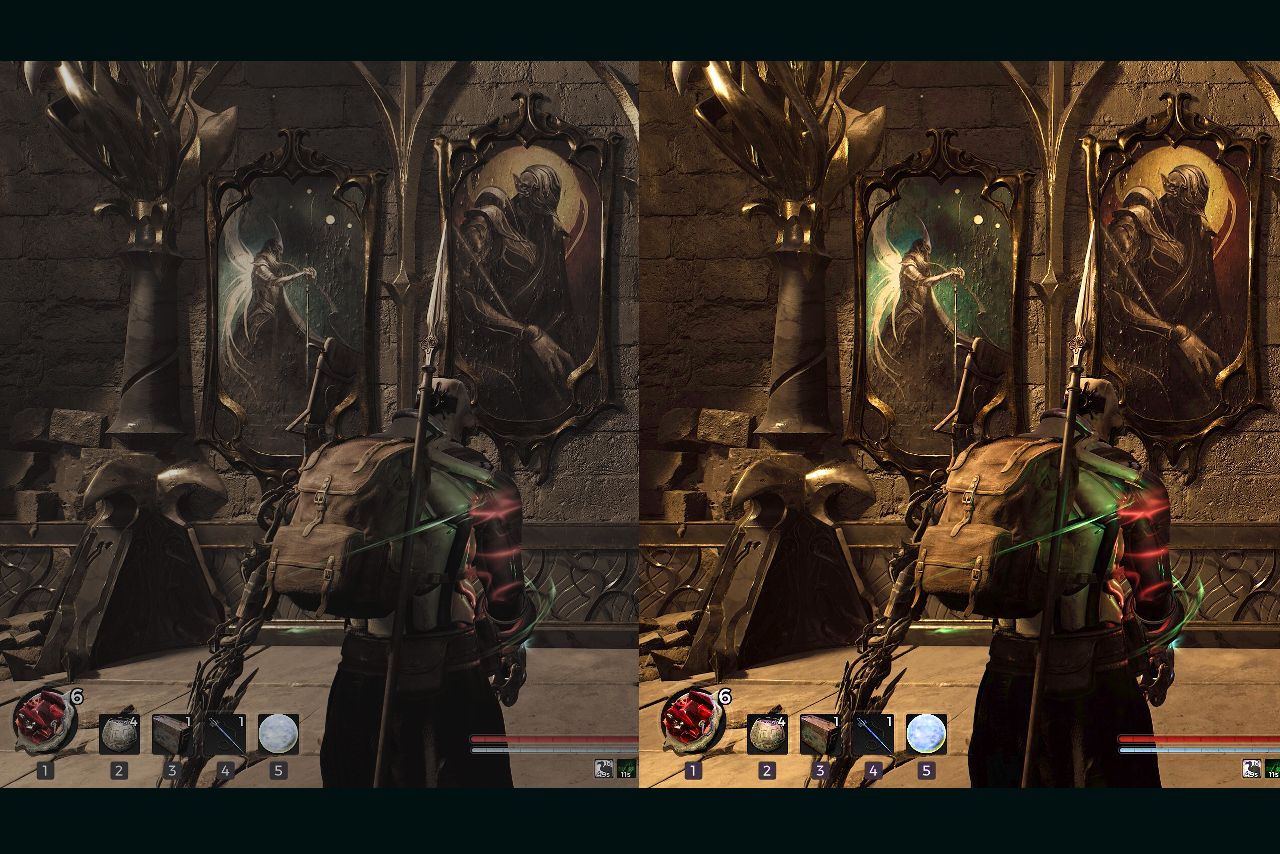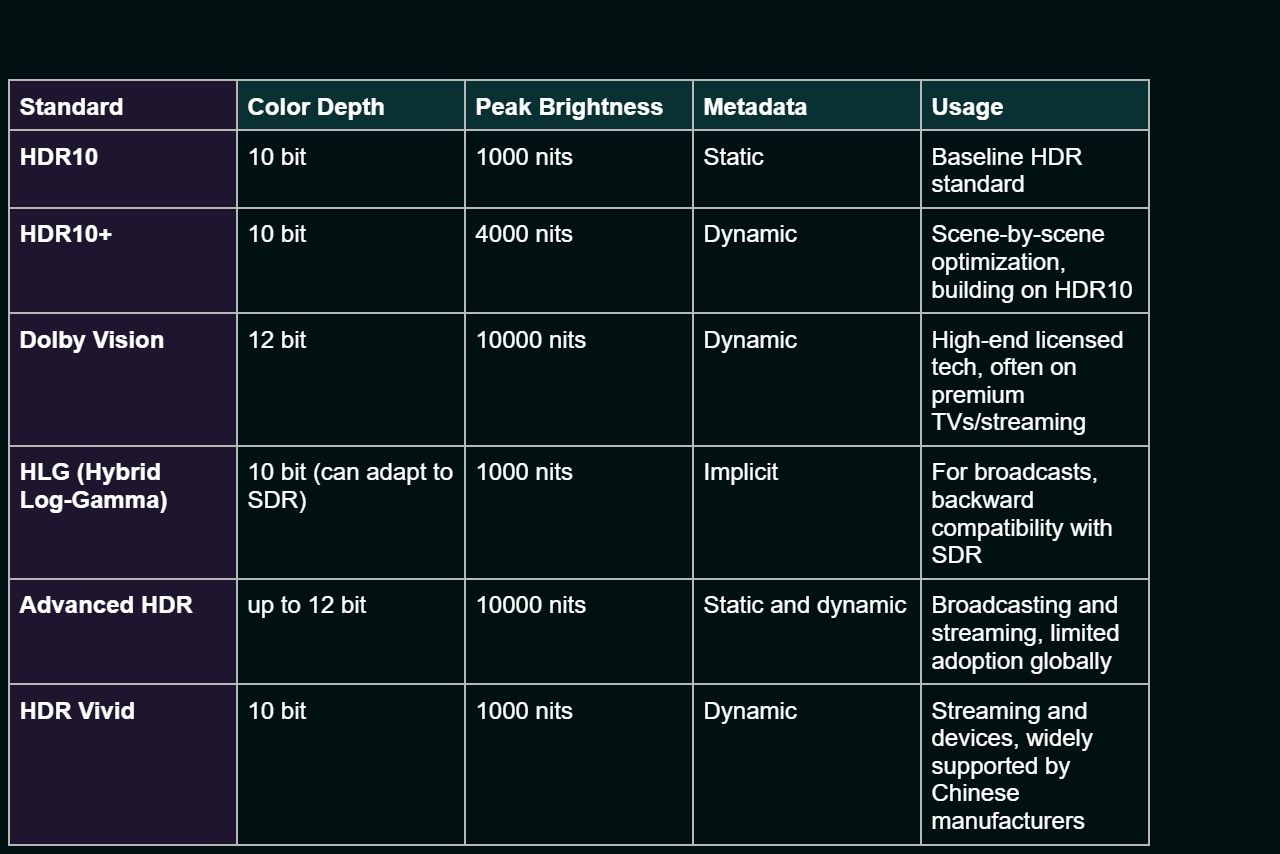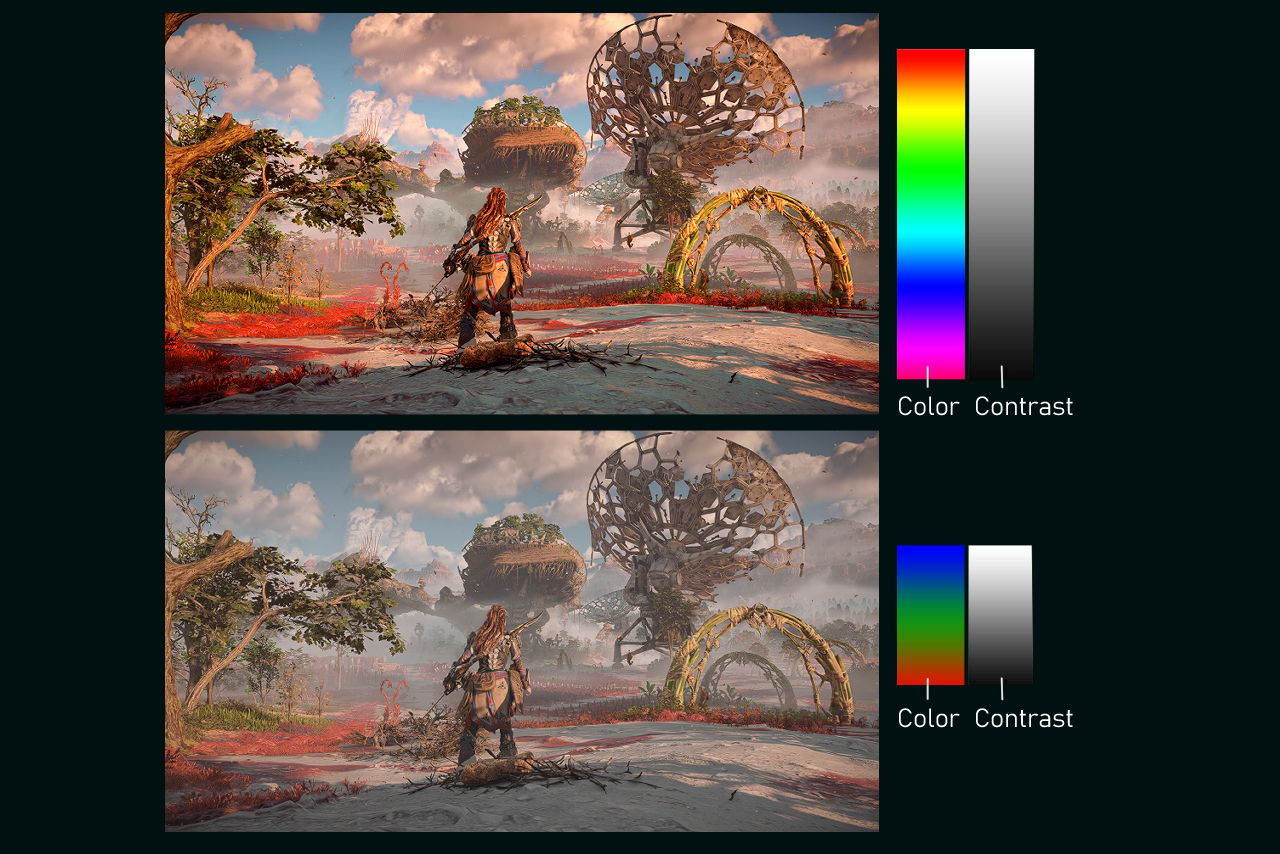
HDR: An In-Depth Guide to High Dynamic Range in Media
|
|
High dynamic range (HDR) is a display technology that focuses on a wide dynamic range of luminosity (brightness) for stronger realism. It combines an extended dynamic range (sometimes referred to as expanded dynamic range) with enhanced brightness and color capabilities. Shadows deepen, highlights radiate, and scenes gain extra depth and feel more immersive. In this article, we’ll explore HDR’s role in gaming, movies, and TV series, look at common HDR formats, and outline how to enable it on different devices.
Table of Contents
- Introduction
- What Is HDR
- How HDR Works
- Types of HDR
- Benefits of HDR in Gaming
- Drawbacks and Challenges of HDR
- Differences Between HDR and SDR
- How to Enable HDR on Your Devices
- Common HDR Issues and Fixes
- TL;DR
Introduction
HDR originally emerged in photographic and filmmaking environments, where pioneers merged different brightness levels into a single image to capture dazzling highlights and subtle shadows simultaneously. Over the years, these techniques evolved into the contemporary HDR pipeline, which has now permeated everything from major streaming platforms to console gaming experiences. Early on, only a small number of displays could achieve the brightness levels and color fidelity necessary to fully demonstrate HDR’s advantages. However, as LCD and OLED panels became more sophisticated, they reached greater peak luminance, handled wider color gamuts, and introduced more advanced local dimming features.
For gaming, HDR revolutionized how immersive gameplay could feel, elevating in-game worlds to levels that standard dynamic range (SDR) could never reproduce. Imagine walking through a dim corridor in a survival horror game: with HDR, the scene’s shadows deepen to genuinely spooky levels, while the flicker of a distant light appears tangibly bright, amplifying tension. Or picture a neon dystopian metropolis under the night sky, where HDR lighting accentuates the dramatic contrasts of neon signs against dark urban backdrops. The balance of radiant highlights and deep blacks transforms the environment into something that feels almost alive.
Beyond gaming, consumers quickly noted HDR’s ability to retain delicate color transitions and nuanced lighting details that SDR often fails to represent. As a result, HDR evolved into a fundamental specification in modern screens, shaping contemporary entertainment in both visual fidelity and overall atmosphere.

What Is HDR
HDR pushes two major elements in video output: how bright the display can get and how expansively it can represent color. Traditional SDR typically limits color representation to 8-bit (roughly 16.7 million color possibilities), with a brightness cap between 100 and 300 nits. The more nits a display has, the brighter it can get. HDR, conversely, often employs 10-bit or 12-bit color, dramatically enlarging the number of reproducible shades, and can climb to 600 nits or even surpass 1,000 nits in certain high-end models.
By conserving detail in both intensely luminous zones and obscured shadows, HDR offers a bolder contrast ratio, delivering vivid highlights and more profound shadow detail. Many HDR displays also cover extended color standards (DCI-P3 or Rec.2020), providing richer hues compared to older color spaces (Rec.709 or sRGB). This depth of palette notably benefits elaborate game worlds and visually stunning cinematic moments. Moreover, HDR maintains a real-world sense of brightness without sacrificing image detail in dimly lit parts of the screen. When configured properly, lamps, explosions, and other bright elements look powerfully brilliant, yet viewers can still distinguish subtle details in darker regions.
Despite this, labels such as “HDR-capable” or “HDR-ready” can be misleading. Not every monitor or TV with these tags genuinely produces the full HDR effect. Displays that can’t surpass at least 600 nits in peak brightness or lack robust color coverage may produce underwhelming results, even if they technically accept an HDR signal. Just enabling an “HDR On” feature in a device’s settings does not automatically equate to a genuine HDR experience. You must pay close attention to the hardware’s true capabilities in luminance, contrast, and color fidelity to see real gains in picture quality.

How HDR Works
HDR rests on two fundamental concepts. Firstly, it extends the possible brightness range, meaning some HDR displays can hit peaks of 600 nits, 1,000 nits, or even exceeding 2,000 nits, numbers that go far beyond traditional SDR. Secondly, HDR relies on tone mapping and metadata to correctly map the mastered brightness to a display’s actual capabilities.
Suppose a piece of content is mastered at a maximum brightness of 1,000 nits, yet your screen only supports 600 nits as its peak. In that scenario, HDR tone mapping systematically scales down those brightness levels so the final image remains balanced and avoids unnatural clipping in highlights. The metadata embedded in HDR signals provides critical instructions about how luminous highlights should be rendered, as well as how deep and dark the shadows can go.
More advanced HDR standards, employ dynamic metadata. This technology enables real-time adjustments from one scene to the next—or even from frame to frame—optimizing how highlights and shadows appear under varying conditions. This approach is extremely useful when there are sudden shifts in brightness, like transitioning from a dark dungeon into a sunlit landscape, preventing highlights from blowing out or shadows from losing detail.

Types of HDR
In choosing a new TV, monitor, or streaming device, it’s essential to grasp the various HDR standards in the market. Each format provides unique features and sets different performance requirements.

When selecting a device or display, pay attention to which HDR formats it supports. HDR10 has the broadest compatibility, but premium streaming services often favor HDR10+ or Dolby Vision to showcase the highest fidelity. If you watch live broadcasts, HLG might be more relevant, while local market preferences or specific brand ecosystems might steer you towards HDR Vivid. Taking note of your use case and matching it with the relevant HDR standard ensures you enjoy the intended picture quality.
Benefits of HDR in Gaming
HDR’s effect on gaming stretches across multiple dimensions of visual fidelity and immersion.
- Realistic lighting and atmosphere. By extending contrast, HDR conveys more realistic lighting than SDR can manage. Lights glow more intensely, but not at the expense of detail in darker areas. This can transform otherwise ordinary scenes into compelling, lived-in spaces.
- Enhanced shadows and highlights. With HDR, headlights in a racing game might look piercing and vivid, while the night sky simultaneously retains starry details. Shadows get stronger dimension, so you can see subtle differences within darker zones.
- Vibrant color palette. HDR’s broader color range makes vibrant elements stand out, whether it’s a sci-fi city drenched in neon or a sprawling fantasy world drenched in sunrise gold. These scenes become visually richer, adding both drama and authenticity.
- Cinematic presentation. In narrative-driven or story-heavy games, HDR enhances cutscenes with filmic qualities, offering delicate gradients and realistic light transitions that reduce the flatness you sometimes see in SDR. Characters and environments gain a tangible sense of depth that heightens overall emotional engagement.
- Increased impact of special effects. Explosions, sparks, and magical spells appear more dynamic under HDR, thanks to expanded brightness and color intricacies. This impact can ramp up the excitement, whether you’re firing off futuristic energy weapons or summoning arcane forces.
- Competitive edge in certain scenarios. In some competitive or horror-themed games, the nuanced difference between dark and bright regions might help you notice an enemy silhouette lurking in a dim area or a resource glinting under sporadic light. HDR can offer a functional advantage by ensuring nothing remains completely lost in black crush or overblown highlights.

Drawbacks and Challenges of HDR
Although HDR can be extraordinary when done right, several hurdles can diminish its payoff.
- Unequal quality among “HDR-ready” displays. Some manufacturers label displays as “HDR Ready” even if they only marginally exceed SDR standards or simply accept an HDR signal without delivering the necessary brightness or color volume. A display with true HDR performance typically must exceed 600 nits at peak brightness, feature robust contrast (sometimes aided by local dimming), and cover a wide color gamut. Relying on marketing alone can be misleading, so checking authoritative reviews or professional tests is invaluable.
- Setup complexity. Implementing HDR can be more complicated on PC than on consoles. Consoles typically streamline the process with integrated HDR calibration options, but you might still have to adjust in-game sliders for brightness and contrast.
- Limited content. While an increasing number of modern games, movies, and TV shows natively support HDR, older productions might not. Some older projects that advertise HDR may rely on post-processing or false HDR methods that produce only minor improvements, or sometimes even degrade visual quality compared to well-done SDR.
- Potential eye strain. HDR’s heightened brightness can cause discomfort if you watch or play in a dark room and the screen suddenly bursts with intense highlights. Incorporating ambient bias lighting behind your screen or toning down the peak brightness in your display settings can alleviate strain without nullifying the HDR effect.
- Marketing confusion. Vague branding like “DisplayHDR 400” only ensures a 400-nit peak, which is relatively low in real-world HDR terms. Some displays meet the bare minimum, offering a slight bump from SDR but falling short of true HDR’s full benefits. Hence, it’s prudent to read technical details and user experiences, not just rely on a simple logo or promotional phrase.
Differences between HDR and SDR
HDR outshines SDR in several key respects.
- Brightness range. SDR often limits brightness to 100–300 nits, whereas HDR can climb to at least 600 nits and, in high-end products, well beyond 1,000 nits, providing much more luminous highlights.
- Color depth. The classic 8-bit configuration for SDR only supports around 16.7 million colors. HDR’s shift to 10-bit or 12-bit color can represent hundreds of millions or billions of distinct shades, enabling more lifelike gradients.
- Expanded color gamut. Unlike SDR’s reliance on sRGB/Rec.709, HDR embraces wider color spaces—DCI-P3/Rec.2020. Scenes can incorporate more vivid reds, deeper greens, and a richer overall palette.
- Better contrast. SDR can result in either washed-out bright areas or inky blacks that lose detail, whereas HDR maintains visibility across the entire luminance spectrum, preserving details in brightly lit segments and within dark shadows.
- Compatibility considerations. SDR works almost universally with older hardware, meaning it’s simpler to set up across various displays. HDR demands modern equipment (including cables) and appropriately mastered content. That additional complexity is worthwhile for those who prioritize exceptional image depth and quality.
Once you witness how HDR heightens sunlit exteriors, star-filled skies, and every gradation in between, the typical SDR presentation can seem comparatively dull. Nonetheless, SDR’s straightforward nature makes it convenient if you don’t own HDR-capable equipment or need a guaranteed baseline experience.

How to Enable HDR on Your Devices
Activating HDR isn’t always a matter of flipping one switch. It often involves multiple steps to ensure the display, source device, and content all sync up properly.
Console setup. Check TV/monitor settings, many televisions require you to enable “HDMI Enhanced” or “HDR” per port to properly recognize an HDR signal. Failure to engage this feature might prevent HDR from functioning.
- PlayStation 5. Head to “Settings”, then “Screen and Video”, and set “HDR” to either “On” or “Automatic”.
- Xbox Series X/S. Go to “Settings”, then “General”, followed by “TV & Display”, and select “HDR Calibration” to match brightness and contrast to your screen’s capabilities.
In-game adjustments. A lot of modern titles incorporate dedicated HDR calibration tools—you can tweak brightness, contrast, and other elements to avoid crushed blacks or overblown highlights.
Enable HDR in Windows. Under “Settings”, “System”, “Display”, look for “Windows HD Color settings” or an HDR switch. If you can’t toggle it, your monitor may be incompatible. Outdated drivers can break or limit HDR functionality, so installing the latest graphics card driver is crucial. Windows 11 offers a specialized calibration tool available in the Microsoft Store.

Common HDR Issues and Fixes
Balancing HDR
Images might appear overly dark or glaringly bright if the display’s HDR settings aren’t aligned with the in-game or system-level calibration. Tweak the brightness sliders in both the game and your display settings until you find a comfortable equilibrium. Some TVs also offer “Tone Mapping” features that can help re-balance brightness.
HDR compatibility
If you’re expecting HDR content but not seeing any improvement in brightness, color, or contrast, your display may not recognize the chosen HDR format (e.g., Dolby Vision, HDR10, HDR10+). Verify that both the content and the hardware are matched to the same HDR type.
HDR and PC performance
Activating HDR can marginally increase the load on your GPU, particularly in demanding PC games. If you experience frame rate drops, consider tuning down HDR settings (if available) or lowering other graphical elements (shadows, anti-aliasing, etc.) to maintain smooth performance.
Simulated HDR
Certain games might mention an “HDR Mode” but don’t offer a genuine HDR pipeline. Instead, they adjust contrast, brightness, and gamma to mimic HDR, which doesn’t provide true expanded luminance or color depth. Real HDR modifies the picture at a deeper level, retaining intricate shadow detail and avoiding highlight clipping. You can confirm genuine HDR operation if your device switches to an HDR mode at the system level (e.g., a console overlay or a Windows HDR indicator).

TL;DR
HDR amplifies both gaming and cinematic media by uniting luminous highlights, robust color representation, and profound shadow detail. When you’re traversing a haunted fortress in a role-playing game or streaming a noir thriller, HDR’s enhanced dynamic range elevates immersion to new heights.
Gamers will notice eye-popping visual effects, ranging from surreal neon reflections to blazing, magical energy beams. Fans of film or streaming series will appreciate accurate color grading and nuanced lighting transitions that reflect directorial intent more closely than SDR can manage.
If you crave a more enveloping visual experience, consider upgrading to a display with genuine HDR capabilities. Make sure to spend time fine-tuning (via console calibration tools or the Windows HDR Calibration utility) to maximize the technology’s potential.
Once you’re accustomed to HDR’s intense peaks of brightness set against its inky, detail-retaining blacks, going back to SDR will likely feel like a notable downgrade. If you want additional tips on identifying actual HDR versus marketing fluff or navigating the complexities of brand-specific features, consult detailed reviews and calibration guides.
In essence, HDR isn’t just a buzzword. It’s a transformative leap forward in how we perceive digital media, providing a closer approximation to what our eyes see in the real world. By addressing both brightness and color breadth, HDR crafts an image that more accurately mirrors natural lighting conditions, intensifying engagement with whatever content you’re enjoying. With the right hardware and configuration, HDR ensures your visual experiences become more lifelike, vibrant, and emotionally resonant than ever before.













